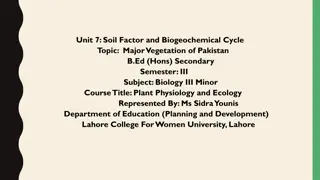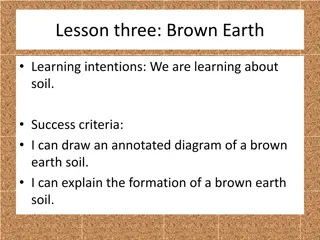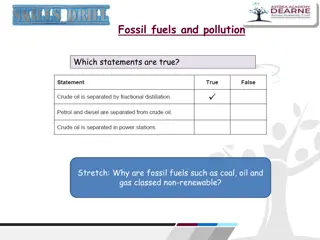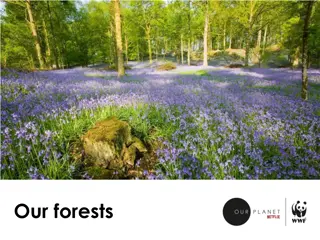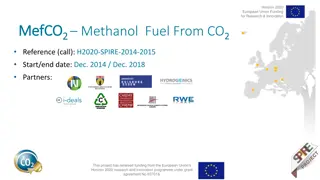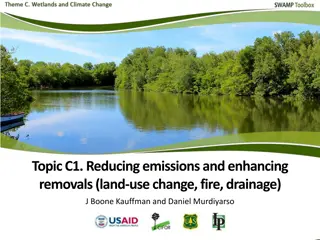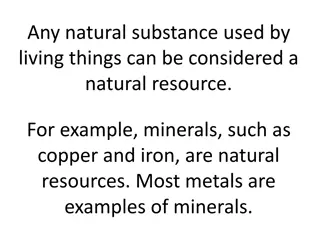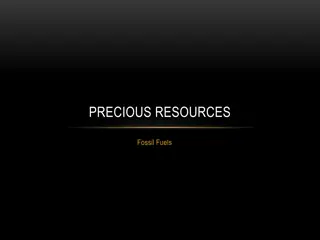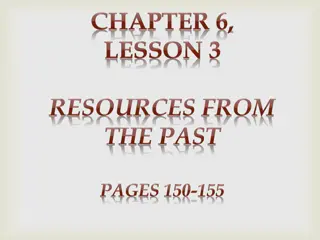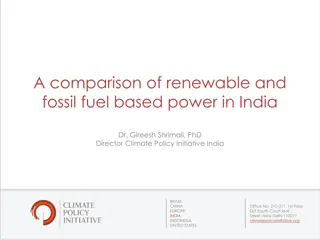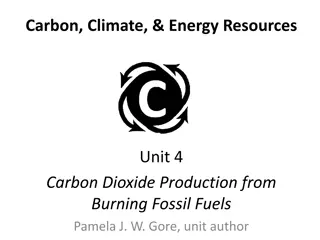Understanding the Formation of Yellowstone Fossil Forests
Researchers Harold Coffin, PhD, Arthur Chadwick, PhD, and collaborators investigated how the Yellowstone fossil forests formed, challenging conventional interpretations with biblically motivated research. The study explores the fossilized trees buried by volcanic debris flows, presenting contrasting views on their origins and offering expectations for different models. The findings highlight the significance of worldview in interpreting geological phenomena.
Download Presentation

Please find below an Image/Link to download the presentation.
The content on the website is provided AS IS for your information and personal use only. It may not be sold, licensed, or shared on other websites without obtaining consent from the author. Download presentation by click this link. If you encounter any issues during the download, it is possible that the publisher has removed the file from their server.
E N D
Presentation Transcript
Yellowstone fossil forests: How did they form? Research by: Harold Coffin, PhD Arthur Chadwick, PhD Collaborators from Geoscience Research Institute and Loma Linda University
Introduction: In the 1970 s the Yellowstone fossil forests were being argued by some creationists as a reason why earth history took a much longer time than is compatible with the biblical time scale. Other creationists predicted that the conventional explanation for these fossil forests must be wrong, and careful research will find that there is a better interpretation for them. Can such biblically motivated research be successful? The experience of the Yellowstone fossil forest research says YES, it can a more correct worldview leads to better answers.
The Eocene fossil forests in Yellowstone N.P. A series of levels of fossilized trees were buried by volcanic debris flows (lahars)
Interpretations: Conventional science - each forest grew in that location, was killed by a volcanic debris flow, and then another forest grew on top of it. This happened many times perhaps close to 100 times Bible-motivated science interpretation, developed after some initial research the trees grew somewhere else. They were killed, uprooted, and transported to this location by water. As this occurred, each layer of trees was buried by a volcanic debris flow. Since the early 1970 s serious research on these forests has been done by creationists, seeking to test between these two models.
Left two fossil upright tree trunks. These are common. Below some fossil trees are very large, with up to 1,000 rings
Expectations of the two models: In situ growth (they grew where they were fossilized, one forest after another) Upright trunks or stumps grew there. There should be soil layers at the base of the trees. The stumps and upright trunks will have roots. Pollen and leaves in the soil will match the type of tree trunks. Decayed and decaying wood and leaves should be common at the soil zones. Tree trunks should not extend up through the next forest level above where they grew (they would be destroyed by the next volcanic flow, or would decay afterwards. If they grew where they were fossilized, the types of trees should all represent the same major environment.
Transport model (they grew somewhere else and were water transported to their site of fossilization, one layer at a time) Upright trunks or stumps did not grow there. There is a process that can bring them there upright. There would be no true soil layers at the base of the trees. The stumps and upright trunks with missing roots the roots were broken off by catastrophic conditions when uprooted. Pollen and leaves in the soil may not match the type of tree trunks at the same location. Decayed and decaying wood and leaves could be present, but probably not common. Probably rare or absent. Tree trunks may extend up through the next forest level; there would probably not be sufficient time for decay as the next forest is transported in around them. The transported trees could have come from a variety of climate zones.
Results Roots: As seen here, the roots were broken off of the stumps or trunks. This was confirmed when it was possible to dig around the base of trunks or stumps.
Results Roots: The broken roots of the fossil trees most closely match the condition seen here in a tree uprooted at the eruption of Mt. St. Helens small, flexible roots are present, but large roots were broken off.
Results Decay: Wood was uniformly well preserved, as seen in this tree. Evidence of decay appears to be rare or absent. In some cases trees with broken out sections could be studied microscopically to verify that they represent broken fossil material, not decay. This research is yet to be done.
Decay: Absence of decay in overlapping tree levels. The tall tree trunk on the right extends up through more than one debris flow layer (more than one forest ). The tree at the left is in the upper forest level. If the tree on the right had experienced this condition, the upper half of the trunk should have been heavily decayed, but it is not decayed.
Dendrochronology, comparison of tree rings: The characteristics of tree rings can be used to evaluate if a set of trees grew together, at the same time, under the same conditions. The width of rings, and unique features like early-wood rings or late- wood rings are very helpful in this comparison.
Compare the rings in these four trees. The rings in all four match the signature in the diagram in the previous slide.
Compare the rings in these four trees. The rings in all four match the signature in the diagram in the previous slide. However, they shouldn t match, because these trees are from different forest levels. The best explanation is that the trees grew together, somewhere else, and were transported in and deposited on different debris flow levels.
Match between wood, leaves, and pollen: There is a poor match between these. Species of trees represented by fossil pollen (see picture below) can be accurately identified. Pollen and leaves do not show a reasonable match with the species of trees represented by wood at that forest level.
Match between pollen and wood species:Tree horizon (level) 5 illustrates this poor match. Brown rectangles are identified tree stumps or trunks. A number and letter (e.g. 5Z) is a pollen sample. Numbers in the chart show the number of pollen of each species in that sample.
Match between pollen and wood species:The same type of comparison for tree horizon 9. This horizon has mostly conifers, which produce huge amounts of pollen, but conifer pollen is far outnumbered by a broadleaf species, Alder.
Soils: Microscopic analysis of the soil levels indicate they are not soil as would be represented in a living forest. They are simply thin layers of fine, water-deposited sediment. They do not contain decaying leaves etc. as would be found in a true soil. As seen in the two samples shown here, the soil layers show water sorting. The dark lines are cross-sections of well- preserved leaves, often with sorted, graded sediment between them. Lower right: the dark spots are broken (not decayed) organic matter.
Ecology represented by the trees: The tree species represent a wide variety of life zones, that would not grow together. These include tropical and semitropical forests (some from southeast Asia today), and high elevation temperate mountain forests. This is most easily explained if the plant material was transported from different places, and deposited together here in what is now Wyoming.
Mt. St. Helens - modern analogue for deposits of uprooted and broken trees. In 1980 Mt. St. Helens erupted and devastated the surrounding forests.
Mt. St. Helens - modern analogue for deposits of upright uprooted and broken trees. Many of these uprooted stumps and trees were carried into nearby Spirit Lake.
These trees gradually shifted into a vertical position and settled down on the bottom of the lake, still vertical, similar to the Yellowstone fossil trees. This is a direct analogue showing how the fossil trees may have been deposited.
These stumps were carried by a catastrophic debris flow for 60 miles down the Toutle River drainage when Mt. St. Helens erupted. Some are sitting on top of a highway, showing they did not grow here. They remained upright, indicating how such stumps tend to remain upright in spite of rough treatment.
Source of the volcanic debris flows: The source of such sediment can be identified by comparison of trace element profiles of samples from the individual debris flows and from nearby volcanic vents from which the debris flows could have originated. Several such vents were identified in the Yellowstone area. Three of these vents alternately sent debris flows into the fossil forest deposits. Each of these sources could be identified at various levels through much of the vertical sequence of fossil-bearing levels.
Conclusions Several lines of evidence do not seem to be explained by forests buried one forest after another, killed and buried where they grew. The data are best explained by the following sequence of events: Forests growing elsewhere, in a variety of climates. The forests were catastrophically killed and uprooted. They then were water transported and deposited in a basin, as several volcanic vents buried them in a series of volcanic debris flows. Later this area was uplifted to a higher elevation, along with much of this part of North America.
Conclusions This research is an example of how a biblical worldview can motivate productive scientific research. The hypothesis that an alternate interpretation of the fossil forests was needed came from the biblical time frame for earth history, and then this hypothesis was followed up by careful data collection and analysis, as would be done by any geologist. Since the Yellowstone deposits look, on the surface, like forests that grew there and died there, conventional science did not motivate anyone to seek a different interpretation. In fact, without the biblical record (an eyewitness telling us facts about earth history) it would probably seem silly to suggest that a different interpretation was worth looking for.






